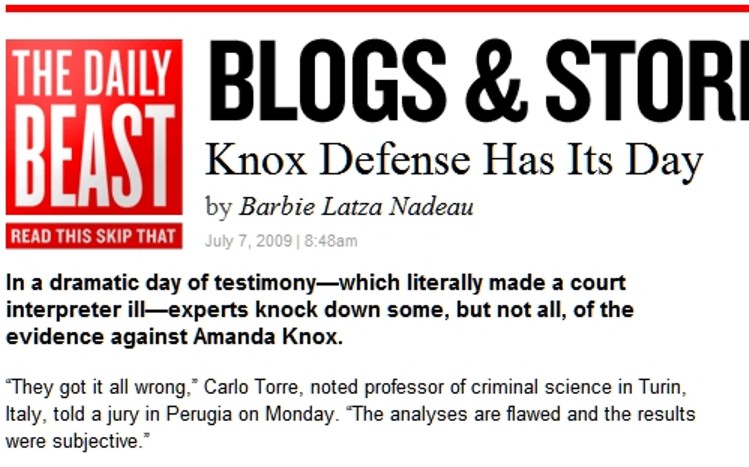
Wednesday, July 08, 2009
Defense Experts Testimony: Daily Beast Posts The Most Detailed Report In English
Posted by Peter Quennell
Click above for the report by Barbie Nadeau on the disputatious knife and DNA-handling evidence..
[Coroner Torre and genetic expert Gino] testified that “Exhibit 36,” a knife found in Sollecito’s apartment with Knox’s DNA on the handle and Kercher’s on the blade, cannot be the murder weapon. Torre showed pictures of Kercher’s wounds to the jury, then used a mannequin to demonstrate that this knife was too big to make two of the wounds in Kercher’s neck. He conceded that a third larger wound could have been made with the knife, but said it was more likely it was made by twisting a smaller knife….
Although Torre and Gino, who did not examine Kercher’s body, both testified that they saw no evidence that more than one person was involved in her murder, countless prosecution witnesses, including two coroners who did examine Kercher’s body, testified that the 47 cuts and bruises indicated that “more than two hands” were at work.
Comments
FROM DAILY BEAST
“Gino then testified that the DNA on the knife, alleged to be Kercher’s, was not tested properly. The amount of biological material on the blade was so small that it could not be double-tested, she explained, citing a number of forensic-science studies that establish double-testing as the standard protocol for admissible DNA. And she said it should be thrown out of evidence because there was not enough material for the defense team to conduct their own verification tests. “The sample that tested positive for Kercher’s DNA was so small it had to be amplified much more than normal,†she told the jury. “It should not be admitted into evidence.â€
Does she make a good point here? If standards say that if DNA evidence is so small so as not to be accessible to the defence for further tests then should it be admitted as evidence?
Does anyone know if it’s standard practice and they’ve let it slide in this case or does it differ from case to case? The amplification issue comes up as well. I wish she’d given more details on that because I’ve heard some mad numbers on other blogs re amplification and I suspect they are overstating it.
The knife evidence has brought much confusion to the case as well. Namely, premeditation which I think doesn’t sit right in many people’s minds - especially given that Knox and Sollecito had plans that fell through at the last minute.
Very positive points for the prosecution. The lack of testimony refuting the DNA evidence on the bra clasp. You can’t just pretend it’s not there, which is what in esscence she seemed to do by stating that only Guede and Meredith’s DNA was in the room.
There’s a lot flying around on other blogs about “multiple DNA” on the bra clasp. It’s not come up in court yet. Is that another myth?
The “It’s not logical but not impossible” comment when referring to the Knox / Meredith DNA blood spots, also seems very strong for the prosecution. If they were talking about one drop of blood, that could put doubt in a jury’s mind. When you’re talking about several instances of mixed DNA, and one in another housemate’s room, then surely it moves from “It’s not logical but not impossible” to pretty much an impossibility.
Ciao,
Just a brief comment on allowing DNA as evidence: I US - as far as I understand - it is the judge who decides if DNA is allowed to appear as evidence in a trial. As I get the Italian system - albeit different - the working in this matter is much alike: that it is the residing judge who decides if DNA tests are admissibly as evidence.
But science and law are two different matters, and a judge cannot decide upon the scientific quality of a piece of evidence. Standardisation of testing procedures serves as a platform to make DNA common evidence in trials, but all types of scientific statements rest in part upon professional judgement, i.e. nature does not speak for it self, but needs an interpreter who ‘read’ the signs of an instrument.
At present there is a discussion within the legal institutions in US about DNA evidence at trials; DNA is considered ‘unfair evidence’ by some, as jurors allegedly cannot understand when DNA material is to be considered evidence.
This discussion is emerging on the backdrop of a large number of US-cases where DNA did play an important part in a jurys conviction, but where the convicted later is found innocent based upon new DNA tests. Profoundly DNA evidence has pointed out a constitutional problem in the US system, as everyday common logic is not enough to comprehend DNA, and the pitfalls of DNA technology.
Fiori
Where next:
Click here to return to The Top Of The Front PageOr to next entry The Other Long-Term Shadow That Hangs Over Perugia….
Or to previous entry Trial: Italian Reporting On Autopsy Consultant Seems Brief And Unswayed

